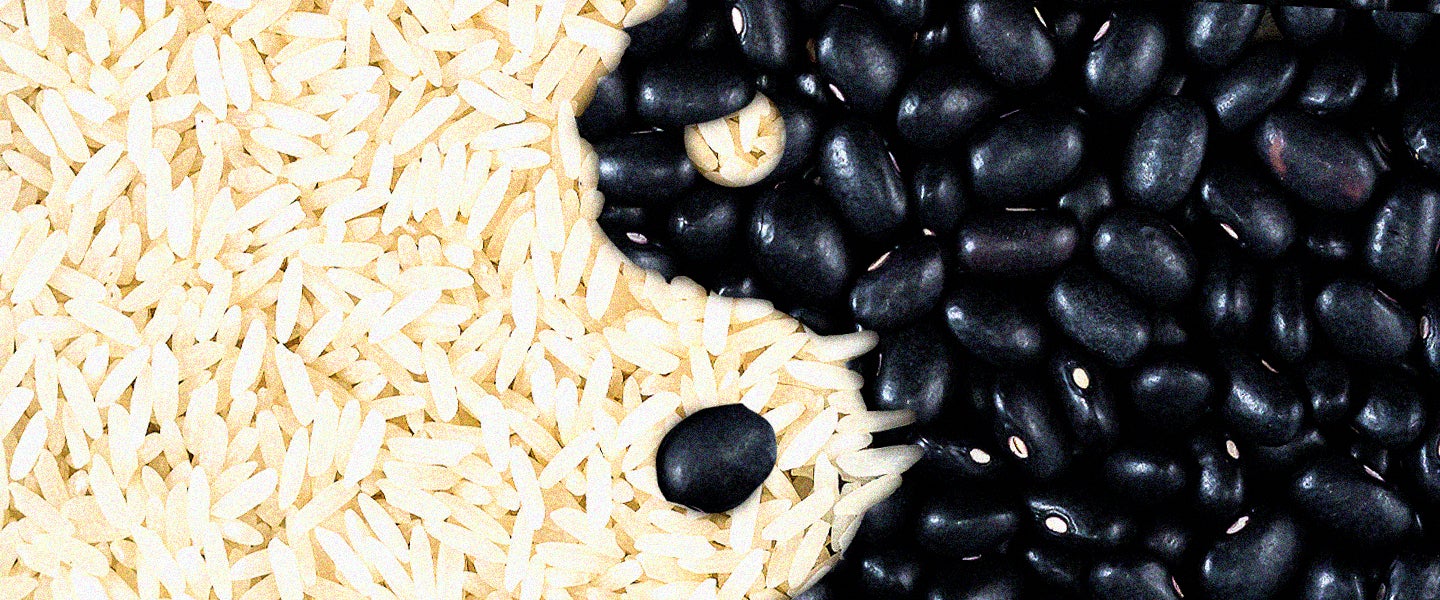If you could only eat one thing a day and it had to be the same thing every day, you really only have two options: 1) You could eat a potato; or 2) you could eat rice and beans.
For variety’s sake, don’t pick the potato.
Admittedly, this isn’t as strict as it sounds. You could pick spaghetti as your grain, and if you pair it with a peanut-butter-based sauce, boom — you’ve just created a complete protein the same as rice and beans. Basically, the key is to combine a grain protein and a legume. Or in simpler terms: rice and beans.
So what exactly is a “complete protein,” and how is that different from, say, an animal protein?
A protein is a protein is a protein, but not all proteins are the same. As such, an animal protein is similar to a plant protein, but different, too. The biggest difference comes down to the amino acids. Animal proteins are considered “naturally complete” because they offer all nine essential amino acids we require (histidine, isoleucine, leucine, lysine, methionine + cysteine, phenylalanine + tyrosine, threonine, tryptophan and valine).
All plant proteins, however, are low in at least one of the nine essential amino acids (potatoes being the exception). This is why beans and rice together are kings, but alone are mere princes. Because while beans don’t offer much in the way of methionine, most grains are loaded with it. On the flip side, while grains are low in lysine, legumes are stacked with it.
Admittedly, some vegan and vegetarians don’t like this framing of plant proteins. They resent the idea that plant proteins are considered incomplete. Michael Greger who runs NutritionFacts.org has argued that the only protein that’s incomplete is gelatin, which is actually an animal-derived protein. (It’s missing tryptophan.) To his way of thinking, it’s more about the amount of plant proteins we eat.
But again, the healthiest consumable form of proteins is a mix of grains (e.g., wheat and corn) and other plant proteins, specifically, legumes (e.g., peanuts and beans, soy and chickpeas) — especially if it’s all you’re gonna eat. (It’s food science.) The reason is that wheat (22 percent), oats (21 percent) and even hemp (23 percent) all fail by themselves to provide the protein levels recommended by the World Health Organization and U.N. Food and Agriculture Organization’s amino acid requirements.
Now, there are many plant proteins that do fully provide the recommended daily protein levels — for instance, potatoes (37 percent), corn (32 percent), peas (32 percent), brown rice (28 percent) and soy protein (27 percent). (In fact, potatoes offer more protein, on average, than eggs.) Yet, if you depended on those plant proteins by themselves, none would provide all the amino acids your body requires (once more, save for the potato).
As this paper from the National Institutes of Health shows, “Soy, microalgae and pea contain 4.6, 5.3 and 5.9 percent lysine, respectively, but are low in methionine. Alternatively, corn, hemp and brown rice contain 1.7, 2 and 2.5 percent methionine, respectively, but are low in lysine. Oat, lupin and wheat protein are low in both lysine and methionine, whereas potato protein contains sufficient levels of both lysine (6 percent) and methionine (1.6 percent).”
What all that means is, if you combine tofu (soy) or peas with brown rice or corn, you can create a dish that offers all the same nutritional protein benefits as a hearty meal of pork or beef, chicken or turkey. Better yet, it’s much, much cheaper, and you don’t need to eat as much of it as you would meat, which means less work for your digestive system.
You can keep things interesting, too, by letting your plant proteins be flexible. This is more like a general prescription; the real idea is legumes and grains. So think beans and rice, but also think hummus and pita, or a peanut butter and jelly sandwich on whole wheat. Think refried, black, pinto or red beans paired with brown rice, or perhaps a corn tortilla. Think bean stew and injera, sweet congee and tofu, peanut sauce and noodles.
You get the idea.
Oh, and be sure to wash your beans before you cook ‘em, or you’ll have the kind of gas that will help you to never forget that offered kitchen wisdom.

